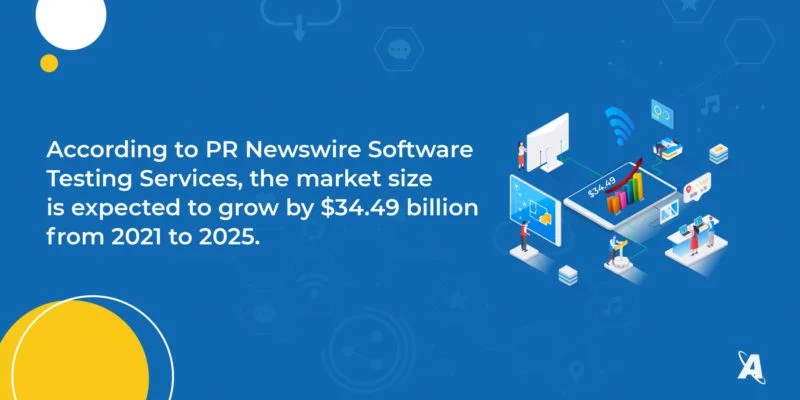Top 6 Reasons Why Automation Testing Strategies Fail

Whenever there is a new technology or tool creating buzz in the market, we immediately ask “What is the success rate of that tool?”
You should, too.
Take testing automation, for example. One of the biggest tech buzz terms in recent years, testing automation helps organizations deliver high-performance applications while optimizing their time-to-market efforts. However, testing automation does have some pitfalls.
This blog will explain the top reasons why more automation testing projects fail than expected.
Automation has become a new norm across industries and businesses to save time, energy, and time-to-market. Amid the growing demand for delivery of quality applications, the need for application test automation has also increased in concurrence.
But before adopting modern automation testing tools and strategies, remember to ask:
- Why do we need this?
- Is this the right time to adopt?
- Who will handle this?
- How could we fail?
Pay special attention to that last one.
If you are on the verge of automating your application testing, it’s vital to know the top reasons why many test automation projects fail. Even more importantly, if you derail from the automation process or choose the wrong automation testing tool, you can negatively impact your product’s performance and overall business growth.

Before we explore the top reasons why automation testing fails, let’s cover the four questions you need to ask before you can move forward with automation selection adoption.
4 questions to ask before adopting testing automation
1. What is your goal with test automation?
Testing automation can cover a wide range of needs. It’s important that you and your team have a clear understanding of your end goal.
For example, your goal could be:
- Reducing the number of tests
- Reducing the overall time to perform tests
- Allowing your team to focus on crucial activities rather than tedious tasks
2. What about implementation?
Once you have clear goals, the next answer you must determine is who will implement the test automation tools.
First, evaluate your internal team’s capabilities to understand whether they can implement the tools, and then find a specialist if they cannot.
3. What’s your execution strategy?
Execution strategies are crucial to consider before you adopt automation testing. In this stage, you should answer the following:
- What is being automated?
- When would you like to run automation scripts?
- How frequently are scripts supposed to run?
4. Who will focus on maintenance?
One major obstacle with automation testing is documentation and maintenance. Many organizations struggle to maintain automation test scripts, which means successors might not be notified of upcoming changes or features.
Letting your automation test scripts go unmonitored for too long will make the data unreliable and obsolete.
Make sure you have answers to the above questions to make your automation testing strategy fruitful and reap the maximum benefits.

Why do testing automation projects fail? Top 6 reasons to know now
- Using automation for the entire process
- Lacking the right skills and using the wrong testing tools
- Ignoring the CI/CD pipeline
- Replacing manual testing with automation testing
- Low visibility
- Lack of analysis of tests after execution
1. Using automation for the entire process
Trying to automate the entire process will actually create roadblocks. That’s because the automation testing strategy is not a magic wand that allows you to automate every task in the software delivery cycle.
Before starting your test automation journey, you must identify what to and what not to automate.
Here is the list of tests that you can automate to save time and energy.
- Functional tests
- Smoke tests
- Structural tests
- Cross-browser testing
- Automation of test input generation
- Load and performance tests
- Regression tests
Remember, automation testing is meant to streamline your operations, not complicate them.
2. Lacking the right skills and tools
In our 15+ years of software development and testing experience, we have found that the lack of the right skills and tools is a crucial bottleneck for many enterprises. Many believe automation is auto-magic and expect the automation testing tools will take care of everything.
But, it doesn’t work like that. Many enterprises struggle to onboard qualified and skilled QA and testing experts and to ensure the application testing process is smooth and meets expectations.
Another big challenge for enterprises is to choose the right set of automation testing tools. Many enterprises think they need every testing automation tool and eventually end up spending a lot on software testing tools acquisition. Additionally, using a test automation tool just because it is open-source might not yield any results.
Check out the list of the top 6 software automation testing tools.
3. Ignoring the CI/CD pipeline
Continuous integration and continuous delivery (CI/CD)) are crucial in software test automation. The CI/CD pipeline in testing automation ensures every minor change in the software development will be tested and reflected immediately for the end-user to ensure better performance and a seamless experience.
But most teams often don’t integrate their CI/CD pipeline with the testing process, failing to reap the full potential of automation testing tools. On the other hand, not embracing the QAOps testing framework can also lead to test automation failure.
4. Replacing manual testing with automation testing
This is one of the myths of software automation testing. Many enterprises and even tech leaders think that automation testing can replace every manual operation.
The truth is that automation testing can never entirely replace manual testing. It is just a complementary process to accelerate product development, debugging, and delivery.
There are many scenarios like UI and navigational testing that require human intervention and thus manual testing. So, before starting application testing, you must define what to automate and what to test manually.
100% automation is a myth.
5. Low visibility
Low visibility and lack of communication are two major factors affecting the success of testing automation. If the key stakeholders are not informed or are unaware of the process, they don’t consider automation seriously, leading to test automation failure.
If the right people in the company are not informed about automation, it will negatively impact the collaboration and visibility of results across teams.
6. Lack of analysis of tests after execution
This is another common reason why most automation testing projects fail. Many enterprises think automation testing tools will take care of everything, and that instead of analyzing results, they can just go relax on the couch.
But regardless of the automation tool, you must analyze the performance of a specific testing tool and make necessary changes to ensure improved performance and reduced time-to-market.
Automation testing doesn’t help if you don’t thoroughly analyze the results.

[source]
Summing it up
Testing automation is one of the comprehensive approaches to helping your organization achieve:
- Product quality
- Robustness
- Scalability
Remember, don’t rush to adopt automation testing tools and be cautious of hasty implementation. The reasons we’ve outlined are not the only scenarios that can lead to testing automation failure. You are likely to encounter various challenges throughout the process.
Would you like to check how your web or mobile app performs across various devices and platforms?

Head of Quality Engineering




